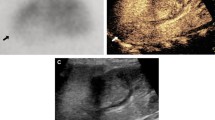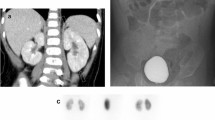Abstract
Objective
Accurate diagnosis of pyelonephritis using clinical and laboratory parameters is often difficult, especially in children. The main aims of this prospective study were to compare the value of different imaging techniques [renal sonography, cortical scintigraphy with technetium-99m dimercaptosuccinic acid (99mTc DMSA) and computed tomography (CT)] in detecting renal involvement in acute urinary tract infections and to determine the sensitivity of DMSA scans for permanent renal scars 6 months later.
Materials and methods
Between February 1992 and January 1993, 55 children admitted to our pediatric unit with febrile symptomatic urinary tract infections were eligible for analysis. Ultrasonography (US), DMSA scanning and micturating cystourethrography were performed in every case. Only 18 children underwent CT. A second DMSA scan was performed in 48 children a mean of 7.5 months after the first.
Results
US abnormalities were found in 25 children (45%). The first DMSA scan showed a parenchymal aspect suggestive of pyelonephritis in 51 patients (93%). Among the 18 patients studied by CT, 14 had abnormalities. Normal US findings did not rule out renal parenchymal involvement. Scintigraphy appeared to be more sensitive than CT for renal involvement. The frequency and degree of initial renal parenchymal damage seemed to correlate with vesicoureteral reflux, but the most severe initial parenchymal defects were not associated with marked clinical or laboratory manifestations. Repeat DMSA scans, performed on 45 kidneys with abnormalities at the first examination, showed resolution in 19, improvement in 16, persistence in 8 and deterioration in 2. The prevalence of vesicoureteral reflux was not higher in patients with renal scarring on the second DMSA scan than in patients whose scans showed an improvement.
Conclusion
DMSA scans should be considered as a reference in the detection and follow-up of renal scarring associated with acute urinary tract infection as this technique is more sensitive than US and CT, the latter being unsuitable because it entails radiation exposure and sedation of patients.
Similar content being viewed by others
References
Lebowitz RL, Olbing H, Parkkulainen KV, Smellie JM, Tamminen-Mobius TE (1985) International system of radiographic grading of vesicoureteric reflux. Pediatr Radiol 15: 105–109
Winberg J, Bollgren I, Kallenius G, Mollby R, Svenson SB (1982) Clinical pyelonephritis and focal renal scarring. A selected review of pathogenesis, prevention and prognosis. Pediatr Clin North Am 29: 801–806
Bjorgvinsson E, Majd M, Eggli KD (1991) Diagnosis of acute pyelonephritis in children: comparison of sonography and 99mTc-DMSA scintigraphy. AJR 157: 539–543
Bouissou F, Belmonte D, Danet B, Baunin C, Raynaud N, Salles JP, Barthe P, Guiraud R (1994) Intérêt de la scintigraphie rénale au DMSA dans les pyélonéphrites aigues de l’enfant. Ann Pediatr (Paris) 41: 7–13
Escobar-Billing R, Fituri O, Karlsson A, Linne T, Wikstad I, Aperia A (1990) 99mTc-DMSA scintigraphy as diagnostic tool in acute pyelonephritis (abstract). Pediatr Nephrol 4: C44–64
Guermazi F, Lenoir P, Verboven M, Smets A, Braeckman J, Jonckheer MH, Piepsz A (1993) Apport de la scintigraphie à l’acide dimercaptosuccinique marqué au technétium99m dans le diagnostic et le suivi des infections urinaires de l’enfant. Arch Fr Pediatr 50: 391–398
Jakobsson B, Nolstedt L, Svensson L, Soderlundh S, Berg U (1992) 99mTc DMSA scan in the diagnosis of acute pyelonephritis in children: relation to clinical and radiological findings. Pediatr Nephrol 6: 328–334
Majd M, Bjorgvinsson E, Eggli KD (1986) The role of renal cortical scanning and US in the diagnosis of acute pyelonephritis in children. Pediatr Radiol 16: 335–339
Melis K, Vandevivere J, Hoskens C, Vervaet A, Sand A, Van Acker KJ (1992) Involvement of the renal parenchyma in acute urinary tract infection: the contribution of 99mTc DMSA scan. Eur J Pediatr 151: 536–539
Meller ST (1987) Radionuclide scans in reflux nephropathy. Arch Dis Child 62: 1292–1293
Sty JR, Wells RG, Starshak RJ, Schroeder BA (1987) Imaging in acute renal infection in children. AJR 148: 471–477
Verber IG, Strudley MR, Meller ST (1988) 99mTc DMSA scan as first investigation of urinary tract infection. Arch Dis Child 63: 1320–1325
Piepsz A, Clarke SEM, Mackenzie R, Gordon I (1993) A study on the interobserver variability in reporting on 99mTc-DMSA scintigraphy. Eur J Nucl Med 20: 867
Glesson FV, Gordon I (1991) Imaging in urinary tract infection. Arch Dis Child 66: 1282–1283
Goldraich IH, Goldraich NP, Ramos OL (1983) Classification of reflux nephropathy according to findings at DMSA renal scan. Eur J Pediatr 140: 212–215
Berg U, Johansson B (1983) Age as a main determinant of renal functional damage in urinary tract infection. Arch Dis Child 58: 963–969
Bouissou F, Danet B, Belmonte D, Salles JP, Barthe P, Guiraud R (1990) DMSA scan in acute infectious pyelonephritis in 150 children (abstract). Pediatr Nephrol 4: C44–63
Shapiro E (1992) Infections of the urinary tract. Pediatr Infect Dis 11: 165–168
Brun P, Legrand I, Hurtier O, Loirat C (1991) Computed tomodensitometry in children with acute pyelonephritis (abstract). Pediatr Nephrol 5: C58–145
Dacher JN, Boillot B, Eurin D, Marguet C, Mitrofanoff P, Le Dosseur P (1993) Rational use of CT in acute pyelonephritis: findings and relationships with reflux. Pediatr Radiol 23: 281–285
Meyer A (1991) Diagnostic des pyélonéphrites aigues. Apport de l’imagerie moderne. Presse Med 20: 1773–1777
De Sadeleer C, De Boe V, Keuppens F, Pintelon H, Verboven M, Peipsz A (1993) Can the outcome of renal abnormalities be predicted on the basis of the initial technetium-99m DMSA scintigraphy? Eur J Nucl Med 20: 867
Glauser MP, Meylan P, Bille J (1987) The inflammatory response and tissue damage. The example of renal scars following acute renal infection. Pediatr Nephrol 1: 615–622
Jodal U, Winberg J (1987) Pyelonephritis: report of the 4th international symposium, Goteborg, Sweden. Pediatr Nephrol 1: 248–252
Ransley PG, Risdon RA (1978) Reflux and renal scarring. Br J Radiol 14: 51–53
Farnsworth RH, Rossleigh MA, Leighton DM, Bass SJ, Rosenberg AR (1991) The detection of reflux nephropathy in infants by 99mTc-DMSA studies. J Urol 145: 542–546
Madj M, Rushton HG (1992) Renal cortical scintigraphy in the diagnosis of acute pyelonephritis. Semin Nucl Med 22: 98–111
Author information
Authors and Affiliations
Rights and permissions
About this article
Cite this article
Lavocat, M.P., Granjon, D., Allard, D. et al. Imaging of pyelonephritis. Pediatr Radiol 27, 159–165 (1997). https://doi.org/10.1007/s002470050091
Received:
Accepted:
Issue Date:
DOI: https://doi.org/10.1007/s002470050091




